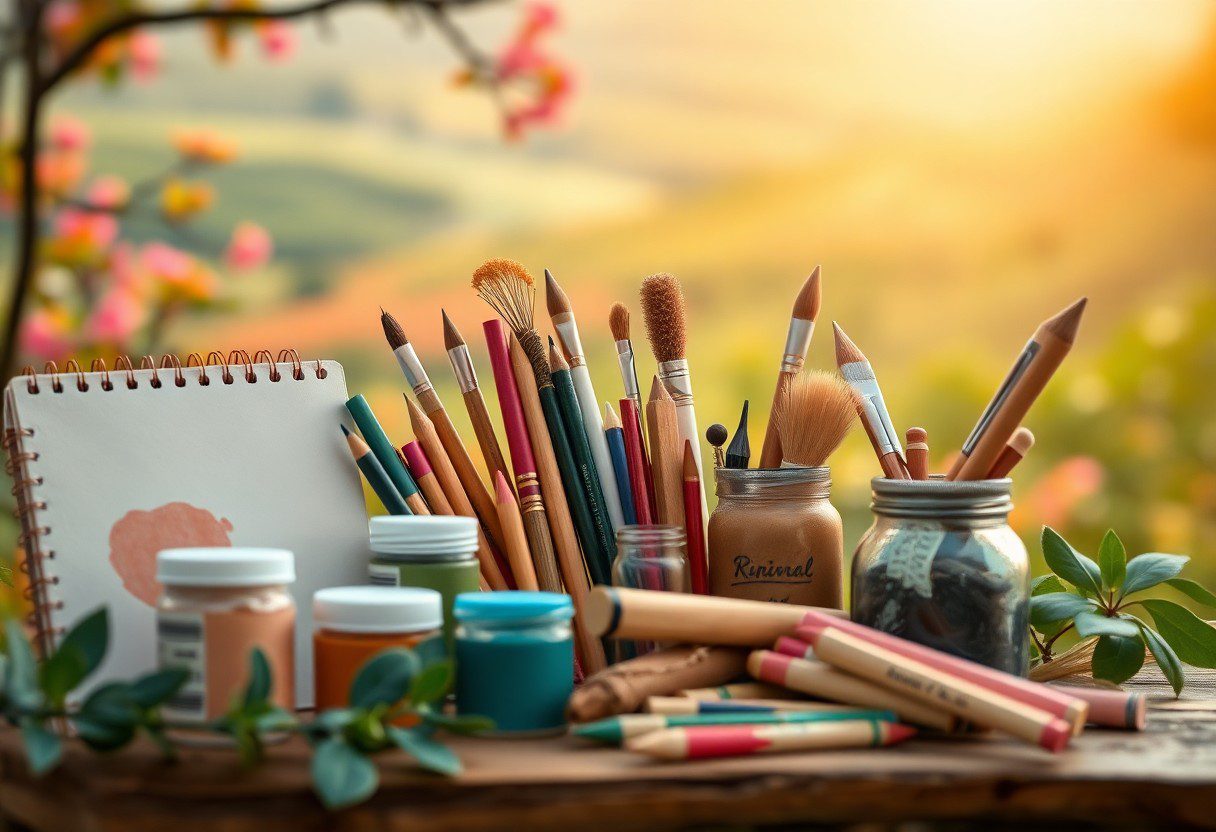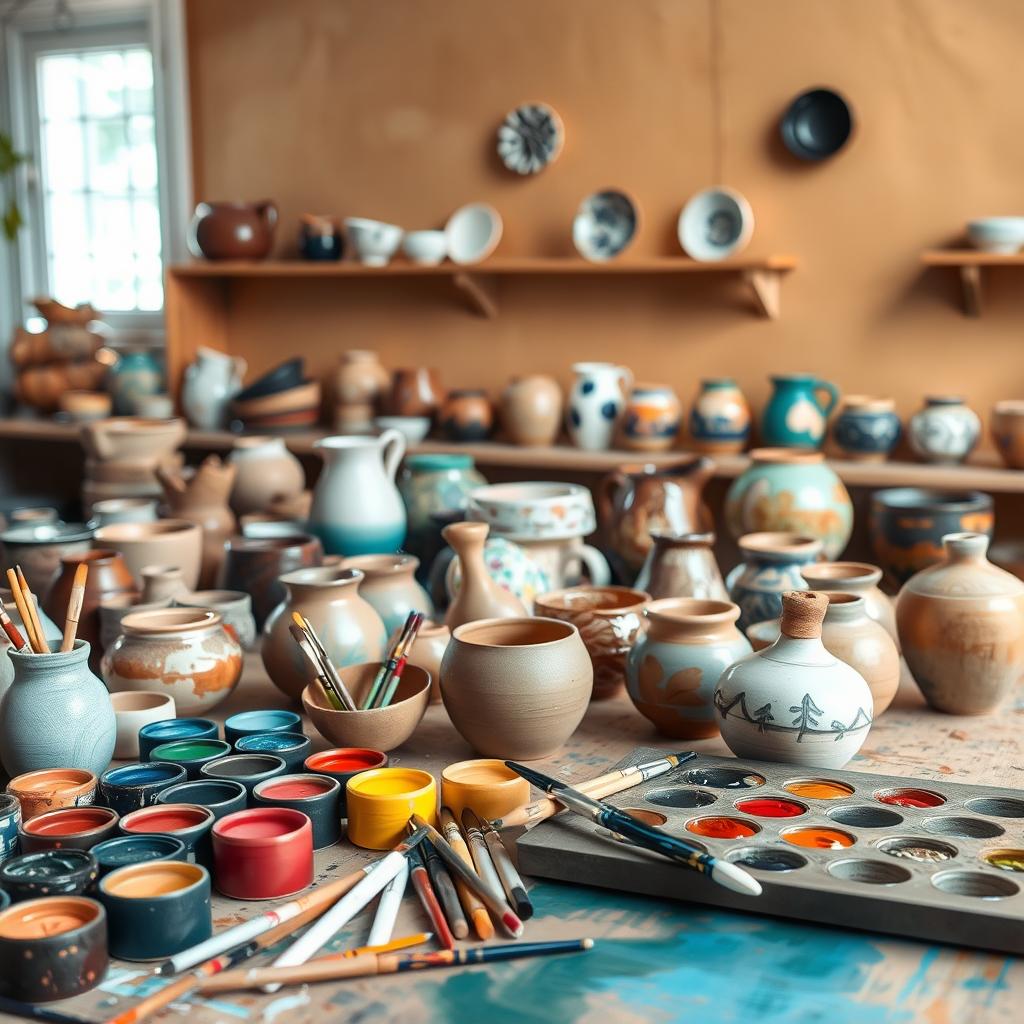It’s time to enhance your artistic journey with eco-friendly art supplies that not only enrich your landscape creativity but also respect the planet. By choosing sustainable materials, you can express your artistic vision while minimizing your environmental footprint. This guide will introduce you to a variety of innovative and sustainable options, helping you make informed choices that benefit both your art and the Earth. Embrace your creativity with supplies that align with your values and inspire your next masterpiece.
Understanding Eco-Friendly Art Supplies
A range of art supplies now exists that prioritizes the health of our planet. By choosing eco-friendly materials, you contribute to sustainable practices that reduce environmental impact. These supplies often use natural ingredients, recycled materials, or eco-conscious manufacturing processes, allowing you to create beautiful art without compromising your values.
Definition of Eco-Friendly Materials
Materials deemed eco-friendly are those that minimize harm to the environment and public health. They typically include biodegradable, non-toxic, or sustainably sourced components. These options not only benefit your artistic expression but also align with a more holistic approach to art-making that reflects a respect for nature.
Importance of Sustainability in Art
Across various creative disciplines, sustainability plays an integral role in shaping your artistic journey. By utilizing eco-friendly materials, you support a cycle of conservation and responsibility that resonates with many contemporary artists and audiences alike. This commitment fosters a deeper connection to the environment and can inspire you to explore themes of nature and preservation in your work.
Definition of sustainability in art goes beyond merely using eco-friendly supplies; it encompasses a philosophy that enriches your creative practice. As you adopt sustainable methods, you become part of a larger movement advocating for responsible consumption and environmental stewardship. Through your art, you can convey messages about climate change, conservation, and the importance of nurturing our planet, all while setting an example for others in your community.
Types of Eco-Friendly Art Supplies
You have a variety of eco-friendly art supplies to choose from that can enhance your landscape creativity while being kind to the planet. Here’s a breakdown of some popular options:
- Sustainable paints and inks
- Recycled and biodegradable papers
- Natural brushes and tools
- Plant-based pastels and chalks
- Non-toxic adhesives and glues
Knowing this variety allows you to select the best materials for your artistic endeavors while promoting sustainability.
| Type | Description |
| Sustainable paints and inks | Made from natural, non-toxic materials that are better for the environment. |
| Recycled papers | Papers created from post-consumer materials, reducing waste. |
| Biodegradable papers | Papers that decompose naturally, leaving no harmful residues. |
| Natural brushes | Tools made from sustainable materials, reducing synthetic waste. |
| Plant-based pastels | Non-toxic options that use natural pigments sourced from plants. |
Sustainable Paints and Inks
Around the world, artists are embracing sustainable paints and inks derived from natural sources. These eco-friendly options are often free from harmful chemicals and solvents, making them safer for use in your creative projects. You can find various brands that offer vibrant colors with minimal environmental impact, enabling you to create beautiful landscapes while maintaining an eco-conscious mindset.
Recycled and Biodegradable Papers
After selecting your paints, consider the type of paper you use for your artwork. Recycled and biodegradable papers are excellent options that help reduce landfill waste. These papers are made from post-consumer materials or natural fibers that easily break down over time, ensuring that your artistic contributions do not contribute to pollution. You can enjoy the creative process with the knowledge that you are supporting sustainability.
It’s inspiring to know that recycled and biodegradable papers come in various textures and weights, catering to different artistic needs. Many brands offer beautiful options that accept various mediums, from watercolor to charcoal. By choosing these papers, you contribute to a circular economy, promoting responsible use of resources and environmental care while creating stunning landscapes. Your choice can significantly influence the sustainability of your art practice.
Eco-Friendly Tools for Landscape Creativity
Even when pursuing your landscape artistry, your choice of tools can significantly impact the environment. Opting for eco-friendly tools not only elevates your creative experience but also aligns your practice with sustainable values. Products made from responsibly sourced materials and non-toxic formulations allow you to enjoy your creative journey while minimizing harm to the planet.
Natural Brushes and Applicators
After exploring eco-friendly options, consider using natural brushes and applicators made from materials like bamboo, hog hair, or recycled fibers. These sustainable choices provide excellent performance while ensuring minimal impact on the environment. You’ll find that natural materials often enhance your painting experience, giving you smooth strokes and improved control.
Non-Toxic Adhesives and Sealers
About your projects, selecting non-toxic adhesives and sealers helps you maintain a healthy work environment while protecting your artistic creations. These products are typically water-based, free from harsh chemicals, and safer for both you and the earth.
Further, using non-toxic adhesives and sealers allows you to complete your craftsmanship with confidence, knowing that you’re supporting sustainable practices. Products like PVA glue and plant-based sealers not only unify your pieces effectively but also reduce off-gassing, making your workspace healthier. By prioritizing these eco-friendly options, you promote sustainability while enhancing the longevity of your artwork.
Sourcing Eco-Friendly Art Supplies
Once again, making thoughtful choices in sourcing your eco-friendly art supplies can significantly impact your landscape creativity. Start by exploring options that prioritize sustainability, such as non-toxic, biodegradable materials and products made from recycled resources. Engage with manufacturers and artists who are committed to minimizing their environmental footprint, and consider product life cycles to ensure you are choosing the most eco-conscious options available.
Local Art Stores vs. Online Retailers
Between local art stores and online retailers, you have choices that can enhance your sustainable sourcing. Local stores often provide opportunities to ask questions and discover regional brands, while online retailers may offer a wider selection of eco-friendly products. Evaluate your preferences for accessibility, price, and support for community businesses when deciding where to purchase your supplies.
Choosing Brands with Ethical Practices
For a more sustainable art practice, aim to choose brands that emphasize ethical practices in their production processes. Look for companies that are transparent about their sourcing, use renewable energy, and have policies in place to reduce waste and emissions.
At the heart of selecting brands with ethical practices is your commitment to integrity in your art-making journey. By researching and supporting organizations that prioritize non-toxic materials, fair labor practices, and sustainable manufacturing methods, you can create artworks that not only inspire but also align with your values. Seek certifications or eco-labels that indicate a brand’s adherence to these principles, ensuring your landscape creativity contributes positively to the environment.
Creative Techniques Using Eco-Friendly Materials
Now that you have selected your eco-friendly art supplies, it’s time to unleash your creativity. Embrace innovative techniques that not only allow you to express your artistic vision but also highlight your commitment to sustainability. By utilizing natural materials, you can create breathtaking landscapes with a minimal environmental impact. Exploring these creative techniques can enhance your artwork while staying true to your values.
Blending Natural Pigments
Above all, blending natural pigments can lead to stunning, rich colors in your landscape art. You can create unique shades and tones using ingredients like crushed flowers, minerals, or charcoal. Experimenting with various combinations helps you achieve a palette that reflects the beauty of the natural world while remaining non-toxic and environmentally friendly.
Exploring Unique Textures
Against the smooth surface of traditional canvases, incorporating unique textures can elevate your artwork. You can use natural materials like twigs, leaves, or even paper made from recycled sources to create dynamic layers and surfaces that enhance depth and interest in your landscapes.
At your disposal are countless possibilities to explore unique textures in your landscape artwork. By integrating elements like sand, dried flower petals, or natural fibers into your compositions, you can add dimension and complexity. This tactile approach not only enriches the visual appearance of your work but also connects you with the essence of nature. As you incorporate varied materials, you create artworks that invite your audience to engage with the textures and stories behind them.
The Role of Community in Sustainable Art
For landscape creativity to flourish sustainably, community engagement is important. When artists unite with their local environments and residents, they create a powerful synergy that fosters eco-awareness and inspires innovative practices. This collaborative spirit not only promotes the use of eco-friendly materials but also nurtures a shared responsibility towards preserving nature. By connecting with others who share your passion for the environment, you enhance your artistic journey while contributing positively to your community.
Collaborations with Local Artists
About collaborating with fellow local artists can elevate your sustainable art practice. By pooling resources, knowledge, and techniques, you can explore new eco-friendly methods and materials together. Working alongside your peers not only broadens your artistic horizons but also strengthens the emphasis on sustainability in your community’s art scene. Engaging with other artists allows for the sharing of ideas that inspire collective environmental stewardship through creativity.
Workshops and Eco-Conscious Art Events
An effective way to engage your community in sustainable art is through workshops and eco-conscious art events. These gatherings provide a platform for you and others to explore environmental themes in creativity while learning about sustainable practices.
Indeed, workshops and eco-conscious art events foster a hands-on approach to learning about sustainable techniques, materials, and philosophies. By participating in these gatherings, you gain valuable insights and skills while connecting with like-minded individuals passionate about preserving the planet. These events encourage collaboration and experimentation, allowing you to turn your artistic vision into an eco-friendly reality. Whether you’re teaching or learning, engaging in such initiatives empowers both you and your community to create art that honors the environment.
Conclusion
From above, choosing eco-friendly art supplies for your landscape creativity not only enhances your artistic expression but also contributes positively to the environment. By selecting sustainable materials, you demonstrate a commitment to ecological preservation while inspiring others in your artistic community. As you explore various eco-friendly options, you can create stunning landscapes that reflect your unique vision and values. Embrace the blend of creativity and environmental responsibility in your artistic journey.
FAQ
Q: What are eco-friendly art supplies, and why are they important for landscape creativity?
A: Eco-friendly art supplies are materials that are made from sustainable resources, non-toxic substances, and often feature recyclable or biodegradable packaging. They are important for landscape creativity because they promote environmental health, allowing artists to create beautiful works without harming nature. Using eco-friendly supplies also encourages a deeper appreciation for the landscape itself and fosters a connection between artistry and nature.
Q: Which types of eco-friendly paints are suitable for landscape painting?
A: There are various eco-friendly paints available that are perfect for landscape painting. Watercolors made from plant-based pigments, acrylics that are low in volatile organic compounds (VOCs), and natural oil paints are great choices. Brands that prioritize sustainability often offer paints that use natural resins and non-toxic colors, making them safe for both the artist and the environment.
Q: Can I find eco-friendly canvas and paper for my landscape artwork?
A: Yes, there are many options for eco-friendly canvas and paper. Look for products made from recycled materials or those that are sourced from sustainably managed forests. Organic cotton canvases and acid-free, recycled paper are excellent alternatives that provide high-quality surfaces for landscape painting while being gentle on the environment.
Q: What tools can I use that are eco-friendly for landscape art projects?
A: Eco-friendly tools for landscape art include brushes made from recycled or sustainably sourced materials, palettes made from biodegradable materials, and pencils crafted from reclaimed wood. Additionally, consider using biodegradable erasers and natural sponges to reduce waste. Opting for tools that minimize environmental impact helps nurture your artistic practice while respecting nature.
Q: How can I dispose of or recycle my used art supplies responsibly?
A: Proper disposal and recycling of art supplies vary depending on the materials. Many eco-friendly paints can be cleaned with water, reducing chemical waste. For non-recyclable materials, check for local hazardous waste disposal programs. Some art supply stores offer recycling programs for paint tubes and containers. Always research local guidelines to find the best eco-friendly disposal methods for your specific supplies.





